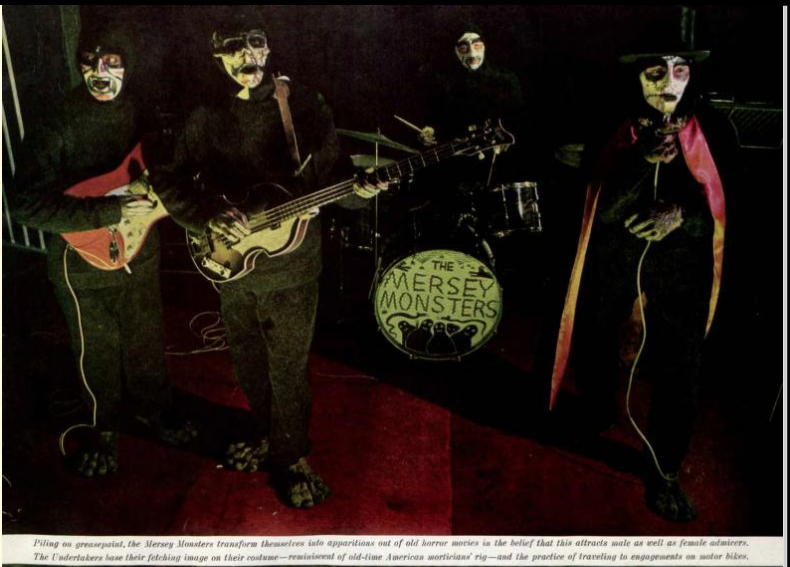February 2021
February 28, 2021
Baitinger’s Automatic Eater
I posted last week about a 1940's invention which envisioned putting restaurant diners on a conveyor belt so that they could be carried past food stations. Several readers commented that the Japanese have embraced the opposite concept, of putting the food on a conveyor belt so that it travels past the diners.I did some research and discovered that the origin of the idea of having food on a conveyor belt traces all the way back to 1919 when John Moses Baitinger of Minnesota applied for a patent on this concept, which he called his "Automatic Eater". His patent was granted in 1923. He had small wooden cars, laden with food and drinks, moving along tracks, pulled by a system of cables.


Karal Ann Marling discusses some of the history of Baitinger's invention in her book Blue Ribbon: A Social and Pictorial History of the Minnesota State Fair:
The ensemble was the invention of the Reverend J.M. Baitinger, an Evangelic churchman, who stationed himself out in front with a megaphone to ballyhoo a new era in state fair dining: "Haba! Haba! Haba! This is the place to be merry. Eat! Eat! Eat! All you want for 50 cents; for without a full stomach you cannot enjoy the fair. Haba! Haba! Haba!"
The Automatic Eater cost Baitinger more than one thousand dollars to build but, because of its novelty and the economies it permitted, the cafe more than paid for itself during a trial run conducted on the last few days of the 1920 fair. "Through the medium of the Automatic Eater," he stated the following summer, "I do away with all excess help and employ only one cook, a dish washer, and a woman to keep the train well stocked with food. I pay no attention to what my customers eat, how long they stay or how much food they consume." But there were healthy profits, which Baitinger turned over to a St. Paul hospital.
Baitinger's Eater was, in many ways, a perfect expression of the mentality of the automation-mad 1920s, obsessed with speed, technology, and efficiency. There were minor drawbacks to the system, however. Diners seated near the end of the line sometimes found that the only cargo left for the eating was boiled cabbage.

Posted By: Alex - Sun Feb 28, 2021 -
Comments (2)
Category: Food, Inventions, Patents, Restaurants, 1910s
The Clairol Beauty Game

This is a game which promotes learning about perms and hair styling.
Source.
Posted By: Paul - Sun Feb 28, 2021 -
Comments (1)
Category: Beauty, Ugliness and Other Aesthetic Issues, Games, Stereotypes and Cliches, 1960s, Hair and Hairstyling
February 27, 2021
Armpit Reading
Useless Superpower: In the 1970s, Chinese researchers investigated reports of children who had the unusual ability to read with their armpits. The kids supposedly could describe what was written on folded pieces of paper tucked beneath their armpits. And not just their armpits. Some kids could see with their ears, hands, or feet.After careful study, the researchers concluded that, yes, the children did seem to have this ability.

Edmonton Journal - Feb 15, 1980
The researchers published the results of their study in Nature Magazine, which is a Chinese journal not to be confused with the British journal Nature. Thanks to the U.S. military's translation service, you can read these articles in English. They're posted on the website of the Defense Technical Information Center. Here's a sample:
Therefore, other pieces of paper were written on in another room by Shen Hanchang and Zhu Chiayi. The papers were folded twice and squeezed through the shirt from the backs of the subjects and placed under their armpits. The two girls held the sample against them with their hands. Besides the two writers, no one else in the room knew what was written on the paper.
After 2 minutes 40 seconds, Wang Qiang said that she "recognized" it. Everyone told her not to speak but to write it down on the side. She wrote a "3" and also wrote "blue". They opened the paper and found there was a "3 6" written with a blue ball point pen. The "3" and the "6" were separated some distance and thus she had recognized one half.
I jokingly referred to armpit reading as a useless superpower, but the Chinese researchers would disagree. They concluded their study with this remark:
Posted By: Alex - Sat Feb 27, 2021 -
Comments (3)
Category: Forteana, Freaks, Oddities, Quirks of Nature, Human Marvels, Science, Eyes and Vision
The Mersey Monsters

Posted By: Paul - Sat Feb 27, 2021 -
Comments (1)
Category: Costumes and Masks, Horror, Music, Pop Art, 1960s, Fictional Monsters
February 26, 2021
Super Paper
Not mentioned in the article below, Derek Best was also selling an adult-version of Super Paper that was printed with sexual suggestions, for subliminal seduction.
Miami News - Aug 27, 1982
Posted By: Alex - Fri Feb 26, 2021 -
Comments (1)
Category: Frauds, Cons and Scams, Hypnotism, Mesmerism and Mind Control, 1980s
Unlikely Reasons for Murder No. 3

Source.
Posted By: Paul - Fri Feb 26, 2021 -
Comments (1)
Category: Death, Hypnotism, Mesmerism and Mind Control, 1900s
February 25, 2021
The Snore Consumer
I've come across reports in early 20th-century newspapers of an invention, designed to stop snoring, that worked by directing the sounds of the snoring into the snorer's own ear.
Oakland Tribune - Nov 26, 1933
I'm not sure if anyone ever really built this device, or if it was just a joke repeated by reporters.
The earliest report of it I've been able to find ran in newspapers in 1871. It attributed its invention to an unnamed woman from Iowa. However, I haven't been able to find a record of anything resembling this in the U.S. Patent Office, although there are numerous patents for anti-snoring devices.

Atchison Daily Champion - Feb 24, 1871
Posted By: Alex - Thu Feb 25, 2021 -
Comments (0)
Category: Inventions, Patents, Sleep and Dreams, Nineteenth Century, Cacophony, Dissonance, White Noise and Other Sonic Assaults
“Wonder” by Ebony Buckle
London-based singer/songwriter Ebony Buckle is back with her latest single “Wonder”. The track is inspired by the world’s loneliest whale. “52” was first discovered in the 80s, singing at a frequency of 52hz (higher than any species known to humans). It was believed that this whale would not be heard by any of the other whales in the ocean, but now after decades of research, there is another theory that the whale’s song is heard by all other whales, as it stands out with its uniqueness. In awe of this natural wonder, Buckle wanted to give us a different perspective of the whale, turning her into an interdimensional traveler, who has lost contact with her home planet. The whale calls and calls for companionship, as she drifts further away.
Source of text.
Posted By: Paul - Thu Feb 25, 2021 -
Comments (1)
Category: Animals, Fey, Twee, Whimsical, Naive and Sadsack, Music, Oceans and Maritime Pursuits, Space Travel, United Kingdom
February 24, 2021
Getaway
Getaway, by Ronald George Eriksen 2 (is the '2' an alternative form of Jr.?), offers instruction on evasive driving techniques. Or, as he says, how to handle a car in the event that someone tries to kill or kidnap you while you're in the car. It was published by Loompanics in 1983, but you can read it for free at archive.org.
In it, you'll find tips such as how to make a smoke screen blow out of your exhaust:
Also, how to do a bootlegger's turn:
(2) Get off the gas and crank the steering wheel to the left ¼ to ½ of a full turn. At the exact same time, hit the emergency brake hard. Those of you with manual transmissions will have to depress the clutch, also.
(3) When your vehicle is at approximately 90 degrees, release the emergency brake, step on the gas, and straighten out the steering wheel. If you have a manual transmission, you will have to let the clutch back out as you are hitting the gas.
(4) Get out of the area fast.

Bootlegger's Turn
Posted By: Alex - Wed Feb 24, 2021 -
Comments (5)
Category: Motor Vehicles, Cars, Books
Cefacidal Promotional Playing Cards

Almost the whole set is here.
Posted By: Paul - Wed Feb 24, 2021 -
Comments (0)
Category: Games, Medicine, Advertising, 1970s, South America
| Get WU Posts by Email | |
|---|---|

| Who We Are |
|---|
| Alex Boese Alex is the creator and curator of the Museum of Hoaxes. He's also the author of various weird, non-fiction books such as Elephants on Acid. Paul Di Filippo Paul has been paid to put weird ideas into fictional form for over thirty years, in his career as a noted science fiction writer. He has recently begun blogging on many curious topics with three fellow writers at The Inferior 4+1. Chuck Shepherd Chuck is the purveyor of News of the Weird, the syndicated column which for decades has set the gold-standard for reporting on oddities and the bizarre. Our banner was drawn by the legendary underground cartoonist Rick Altergott. Contact Us |

